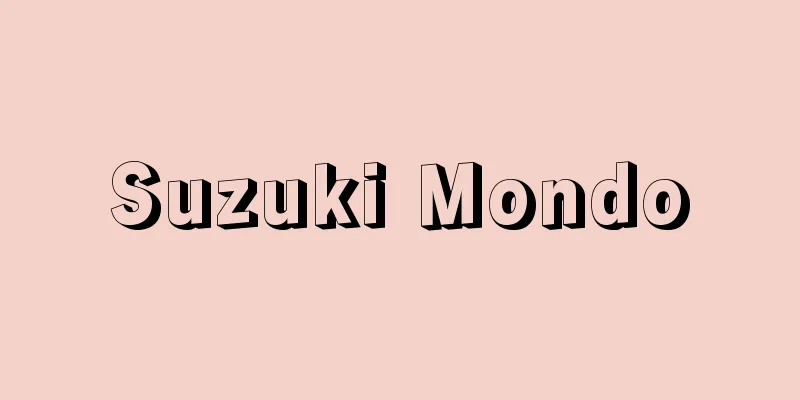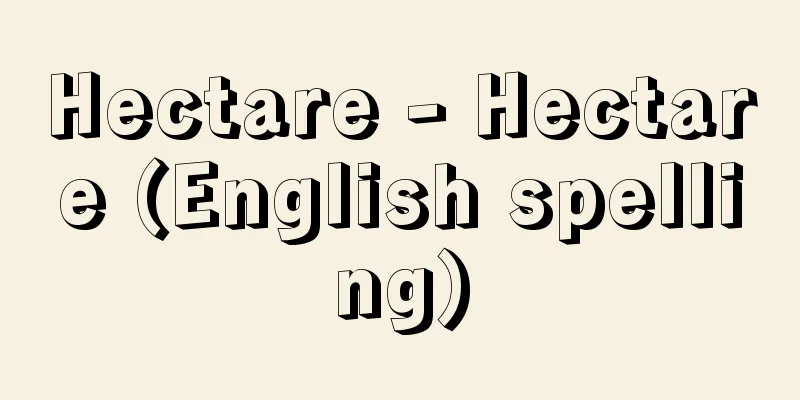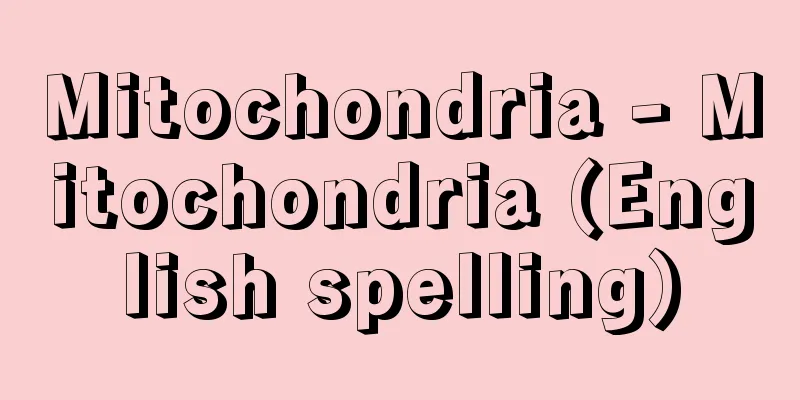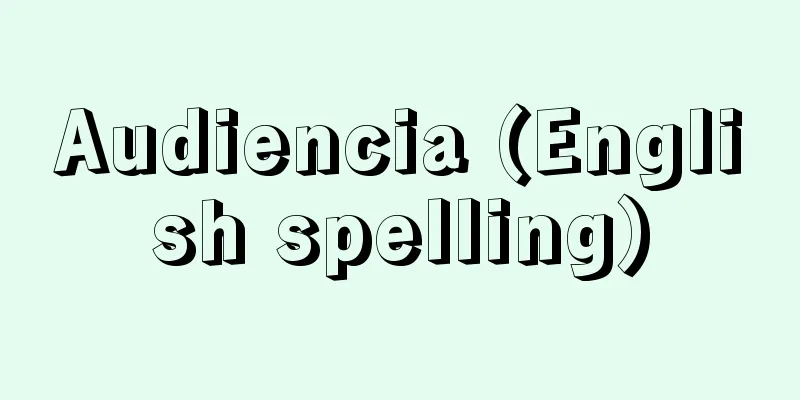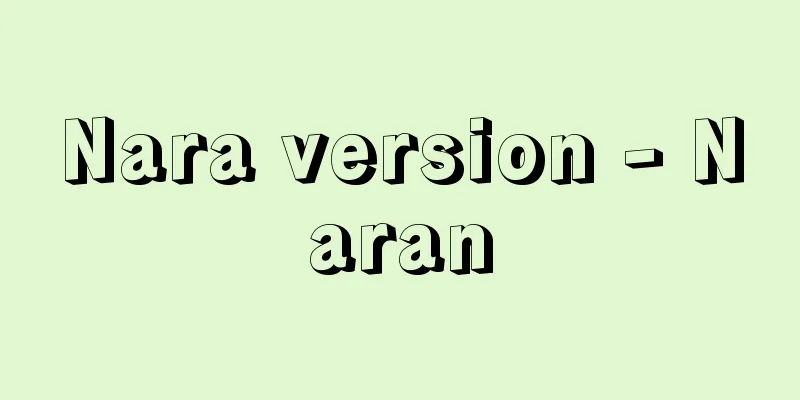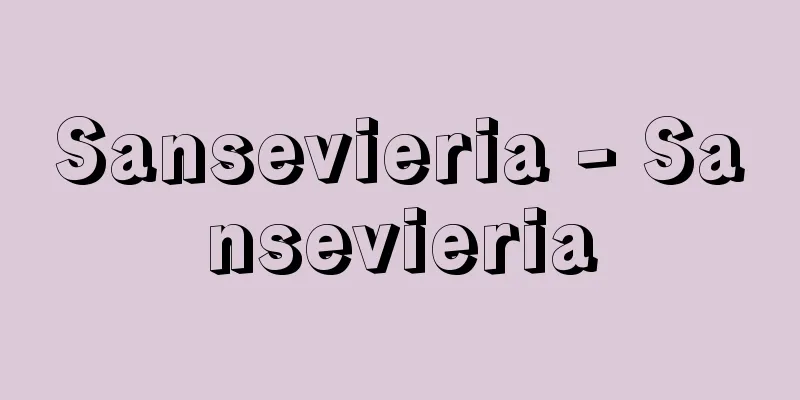Katsuji (English) type

|
Originally, type was the character shape used in letterpress printing, with letters raised to the top of a rectangular metal pillar about 23 mm high, which were assembled to make a printing plate. However, following the spread of phototypesetting in the 1950s, computer-generated character production became more common around 1980. Even so, characters used in printing are still called type, and the original terminology for type and the typeface "tape face" have been passed down. However, when it comes to typefaces for computers, the word "font," which means a set of typefaces, is generally used. [Fumio Hiraishi and Ryutaro Yamamoto] historyDuring the Qingli era (1041-1048) of the Song dynasty in China, Bi Sheng carved characters into clay and baked it to create flat movable type. This technique was passed down from father to son and was not made public, so it did not become popular among the general public. About 270 years later, in 1313, Wang Zhen of the Yuan dynasty created wooden movable type and published his own book, "Nongshu." Copper movable type was also created in Korea in 1227 during the reign of Emperor Gojong. In 1403, a foundry was established at the foot of Mount Namsan and it is said that hundreds of thousands of copper movable type were cast, and they are known as "Kibiji" after the zodiac sign of that year. In 1592, during the invasion of Korea, Konishi Yukinaga and others found copper type and typesetting equipment in the storehouse of the Korean royal palace and brought them back to Japan. These were presented by Toyotomi Hideyoshi to Emperor Goyozei, who ordered his aides to print the Kobun Kokyo using typesetting. This was the beginning of typesetting in Japan. The oldest surviving Japanese books printed with type are the Lotus Sutra Gengi Jo and Tendai Shikyo Gi Shukai, both of which were printed using wood type in 1595 (4th year of Bunroku). The Sagabon (late Keicho period), famous for its beautiful binding and the elegant calligraphy of Honami Koetsu, used cursive wood type. However, because there are many different types of kanji, which require a large number of types, and because clay or wood type is difficult to print with due to its uneven height, this did not become widespread, and subsequent publishing was mainly done using woodblock prints. Around 1445, Johannes Gutenberg in Germany succeeded in making type by melting an alloy of lead and tin and pouring it into a matrix. The 42-line Bible printed with this type is still on display at the Gutenberg Museum in Mainz and elsewhere. Compared to conventional wooden type, this type was easier to manufacture and produced more accurate measurements, so it quickly spread throughout Europe. Western-style movable type was brought to Japan by the Italian Christian missionary Valignano at the end of the 16th century, but disappeared when Christianity was banned. In 1848 (Kaei 1), Motoki Shozo bought type brought by a Dutch ship and founded a printing press. He later learned how to manufacture type from the American William Gamble (?-1886), and also created standards for the size of Japanese type and carried out letterpress printing. This was the starting point for movable type in Japan, and thereafter, manufacturing methods and font styles were gradually improved. A particularly big change in the history of type in Japan was the appearance of automatic cast typesetters (monotypes) that began to be used by newspapers in the 1950s; whereas the phototypesetters that appeared at the same time were called cold type, this method was called hot type. Phototypesetters later changed from manual to computerized phototypesetters, which used an electronic character generation mechanism to typeset the characters in one go; this was completed around 1978 by newspapers, who prioritized speed, in cooperation with electronic equipment manufacturers. This can be seen as the period when the transition took place from optical phototypesetters to electronic phototypesetters. An even bigger change has been the introduction of computers, which have led to a shift to systems where characters can be composed on a display and illustrations and photographs can be inserted. The basic type (characters) are composed of dots, and there are several ways of generating them, such as by drawing the outline and filling in the inside, but as mentioned above, the typeface is called a font and most typefaces have been carried over. [Fumio Hiraishi and Ryutaro Yamamoto] Materials and manufacturing methods for metal typeMetal type is generally a ternary alloy of 73-87% lead, 1-7% tin, and 12-20% antimony. This alloy has a low melting point, fluidity when molten, and easy removal from the mold after casting, making it easy to cast type. It also has excellent properties such as little shrinkage after casting, good printing resistance, and viscosity that prevents type from crumbling during composition. When making emergency type for special characters or characters that were missing, wooden type was made from boxwood or cherry wood. This was used in alphabetic countries and in Japan until the end of the period when movable type printing was introduced. To make metal type, molten type alloy is poured into a casting mold that contains a matrix, which has a lettering surface on one side or one end of a rectangular brass pillar. This mold is placed into a type casting machine, into which type is cast, and the cooled spalls (the umbilical cord of the type, formed in the casting nozzle) are removed to form type. In addition to automatic type casting machines, there are also other casting machines, such as the Monotype (which casts type letter by letter) and Linotype (which casts type line by line), which cast type by striking keys for characters according to the manuscript and selecting a matrix. Both Monotype and Linotype are called automatic typesetters, but Monotypes are also used in Japan because they can type Japanese. [Fumio Hiraishi, Ryutaro Yamamoto, and Miki Nakamura] Shapes and names of metal typeMetal type has a uniform height regardless of size. JIS (Japanese Industrial Standards) specifies 23.45 mm, but in reality, each company used 23.32 mm and 23.45 mm. If the height is uneven, the typeface will be uneven and printing will not be uniform. Nicks (grooves on the side of the type) are there to easily distinguish between the spine (upper side of the character face) and belly (lower side of the character face), size, and font when selecting and typesetting. There are one to three nicks. The cross section of the belly of Japanese type is usually square, and the character does not fill the entire face of the type, but is centered with margins on the top, bottom, left, and right. If the character is large, it will be difficult to read because it is close to the characters before and after it, and if the character is small, it will be difficult to read. Western type has the same vertical dimensions, but the width varies depending on the character. [Fumio Hiraishi and Ryutaro Yamamoto] Font sizeNot only metal type, but both Japanese and Western type are expressed in terms of vertical and horizontal dimensions. [Fumio Hiraishi and Ryutaro Yamamoto] Japanese typeThere are three systems for expressing size: point, double, and number. The point system is used in countries around the world, but there are some differences between continental Europe and the United States and the United Kingdom. Japan uses the American system, which is established as JIS. The point system uses points as a unit (1 point is 0.3514 mm), so for example, an 8-point type has a height of 0.3514 mm x 8 ≒ 2.811 mm. 6 to 10 point types are commonly used for normal printing. The double system is a standard that was once used to indicate the size of Japanese newspaper type, and is made up of u units (0.2794 mm), with 8u being 1x. A 1x type is 8u high, or 2.2352 mm wide, 10u wide, or 2.794 mm wide, and flat. This type is used for the main text, and for headings, 1x and a half, 2x, and 3x types, which are expressed as multiples of the height and width of the 1x type, are used. The Go typeface was invented by Shozo Motoki in the early Meiji period, and was used in the Meiji and Taisho periods, but was gradually replaced by the point typeface. There were nine types of Go typeface, from the largest Go to the smallest Go. Go typefaces were classified as No. 5, which had four sides measuring 1 bu (a whale scale), close to a small pica (an old British and American name for the size of Western characters. 1 pica is 12 US points), and consisted of three series: (1) Go (4 bu), Go (2 bu), Go (1 bu), Go (7 bu), (2) Go (2.5 bu), Go (4 bu), (1.25 bu), (3) Go (1.5 bu), Go (6 bu), and Go (0.375 bu). [Fumio Hiraishi and Ryutaro Yamamoto] Roman typeThe sizes of type varied at first, but today two types of point type are used: the Didot system and the American system. The Didot system was proposed around 1770 by the Parisian typesetter François Ambrois Didot (1730-1804), and one point is 1/72 of the French common measurement of 1 inch. At that time, one French inch was 1.065 inches, the British equivalent, so one Didot point was 0.3759 millimeters. The Didot point is used in France, Germany, and other parts of continental Europe. In 1886, typesetters from all over the United States came together and decided that one point was 1/12 of a pica from the MacKellar, Smith, and Jordan Company. The height of one pica was 0.166044 inches, so one American point was 0.3514 millimeters. The British also adopted this system around 1905. As mentioned above, Japanese point type is of the American system. Since the width of each character in Western characters is different, the width of each type also varies depending on the character. Linn Boyd Benton (1844-1932) of the United States defined the width of all types in 1/6 units, with M being 1, and six types: 7/6 (W), 1, 5/6 (A), 4/6 (abd), 3/6 (ce), and 2/6 (l). However, this was too few widths, so it was later expanded to 12-15 types. The width is determined by the length of a set of type from a to z. The width of the type increases as the type becomes smaller, for reasons of readability. The above are standard typefaces, but there are also expanded typefaces with wider widths and condensed typefaces with narrower widths. In both Japanese and Western languages, there are also consecutive characters that combine two or more letters or numbers into one typeface. [Fumio Hiraishi and Ryutaro Yamamoto] TypefaceJapanese typeThere are Ming, Gothic, Textbook, Qing, Song, and Antique fonts, as well as semi-cursive, cursive, and clerical scripts. Ming is widely used for the main text. It was used during the Ming Dynasty (1368-1644) in China, and has thin horizontal lines and thick vertical lines (1:2-4 ratio), making it easy to read. Gothic is a bold font with uniform line thickness. It is used for headings because it attracts attention. Round Gothic, which has rounded ends, is also used. Textbook characters accurately represent cursive writing, and are used in textbooks for the lower grades of elementary school. Qing is modeled after the style of the Qing Dynasty (1636-1912) in China. It is a style of regular brush script, and is used for greeting cards and New Year's cards. Song Dynasty style is said to have originated at the Zhonghua Book Company in Shanghai, and is a thin style with horizontal and vertical lines of roughly equal thickness and a slightly raised shoulder. It is used for New Year's cards and business cards. Antique style is thick and rounded, with lines of varying thickness. It is used for picture books. Regular regular style is similar to Qing Dynasty style, but has a slightly softer feel. [Fumio Hiraishi and Ryutaro Yamamoto] Roman typeAlthough it only has 26 characters, including capital letters, lowercase letters, and lowercase initials, as well as numbers and symbols, there are about 150 characters, but the typeface is rich in variety, with more than 10,000 varieties. This is because there are many variations in the thickness, width, and serifs (small protrusions at the beginning or end of letters in Roman type that indicate the characteristics of the typeface) compared to the standard typeface. Western typefaces are broadly divided into typefaces for body text and typefaces for display. Typefaces for body text have undergone historical changes and there are many types, but the most representative is the Roman typeface, which is a typeface made from a style that was popular in Italy in the 15th century, with different thicknesses of vertical and horizontal lines and serifs. There are three types: Venetian, old face, and modern face, and many typefaces have been produced to this day while maintaining the basic form. Venetian was the first Roman typeface created by Nicolas Jenson (c. 1420-1480) and others in Venice in the 15th century, and has less difference between thick and thin lines. Old face was created in the 15th and 16th centuries, and has a larger difference between thick and thin lines than Venetian. Modern face was created by Giambattista Bodoni and others, and was completed in the early 20th century, becoming the mainstream of Roman typefaces. The difference between thick and thin lines is even greater, and the serifs are thin and flat. Roman typeface is the equivalent of the Ming typeface in Japanese typefaces, and is widely used in typesetting. Among display type, script is a typeface made by turning calligraphy into type, and is used in ceremonial printed matter and advertisements. Antique is a thick Roman typeface with angular serifs. It is also called square serif (America) or Egyptian (Britain). It is used for display and headlines. Sans serif literally has no serifs (sans means "without" in French), and the thickness of the lines is uniform. It is equivalent to the Japanese typeface Gothic. It is used for display, as well as for body text and headlines. Gothic is originally a typeface from the Gutenberg era, and is an old German script (turtle-shaped script), but in America it refers to sans serif type. Italic is oblique writing, and there are italic types in Roman, antique, and sans serif as well. [Fumio Hiraishi and Ryutaro Yamamoto] [References] | | | | | | | | | | | |National Diet Library "Compilation of drawings and annotations" (unprinted version) Old type edition (Keicho Imperial Edition) Published in 1599 (Keicho 4) Owned by the National Diet Library "> "The Classic of Filial Piety" Volume 1 Published in 1595 (4th year of Bunroku) ( Owned by the National Diet Library ) "An Explanation of the Four Tendai Teachings" ©Shogakukan "> Names of the parts of type ©Shogakukan "> Japanese font size ©Shogakukan "> Point type and number type series ©Shogakukan "> Font type Source: Shogakukan Encyclopedia Nipponica About Encyclopedia Nipponica Information | Legend |
|
本来、活字とは活版印刷に用いられる字型のことで、高さ約23ミリメートルの金属の四角柱の頂面に文字が凸起していて、これらを組み合わせて版をつくり、印刷する。しかし1950年代以降の写真植字の普及に続いて、1980年ごろよりコンピュータによる文字の製作が盛んとなった。それでも印刷に使われる文字は活字とよばれ、本来の活字の用語や書体tape faceを伝承している。ただし、コンピュータ用の書体については、一般に書体の一揃えを意味するフォントfontということばが用いられている。 [平石文雄・山本隆太郎] 歴史中国の宋(そう)代の慶暦年間(1041~1048)に、畢昇(ひっしょう)が粘土に文字を刻し、焼いて扁平(へんぺい)な活字をつくった。この技術は一子相伝として公開されず、一般には普及しなかった。その約270年後の1313年、元(げん)の王楨(おうてい)が木活字をつくって自著の『農書』を出版した。また朝鮮では、高宗の時代の1227年に銅活字がつくられた。1403年には南山の麓(ふもと)に鋳字所を設け、数十万本の銅活字を鋳造したといわれ、この年の干支にちなみ「癸未字(きびじ)」と称される。1592年、朝鮮侵略に際して小西行長(ゆきなが)らが、朝鮮の王城内の校書館の庫内で銅活字と活字版の道具をみつけ、日本に持ち帰った。これは豊臣(とよとみ)秀吉から後陽成(ごようぜい)天皇に献上され、天皇は側近の者に命じ、活字版で『古文孝経』を印刷させた。これが日本の活版印刷の始めである。現存する日本最古の活字本は、1595年(文禄4)の木活字を使った『法華(ほっけ)玄義序』『天台四教儀集解』である。美しい装丁と本阿弥(ほんあみ)光悦の流麗な書体で有名な嵯峨本(さがぼん)(慶長(けいちょう)後半期)には草書体の木活字が使われている。しかし漢字はその種類が多く、多数の活字を必要とし、また粘土や木の活字は高さが不ぞろいで印刷しにくいため普及せず、その後の出版は主として木版であった。 1445年ごろ、ドイツでヨハネス・グーテンベルクが、鉛とスズの合金を溶融し母型に流し込んで活字をつくることに成功した。この活字で印刷した『四十二行聖書』はマインツのグーテンベルク博物館などに現存する。これは従来の木活字などに比べ製造が容易で寸法が正確であったので、ヨーロッパ中に急速に広まった。 西洋流の活字は、16世紀末に、キリスト教の宣教師であるイタリア人バリニャーノによって日本にもたらされたが、キリシタン禁制にあい消滅した。1848年(嘉永1)本木昌造(もときしょうぞう)はオランダ船がもってきた活字を買い、印刷所を創設した。その後、彼は、アメリカ人ガンブルWilliam Gamble(?―1886)から活字の製造法を教わり、また邦文活字の大きさの基準をつくって活版印刷を行った。これが日本における活字の出発点で、その後、製造方法、書体などがしだいに改良された。 日本における活字の歴史でとくに大きな変化は、1950年代に入って新聞社で使用され始めた自動鋳植機(モノタイプ)の登場で、同時期に出現した写真植字機(写植)がコールドタイプとよばれたのに対して、この方式はホットタイプとよばれた。その後写植は、手動式のものから電子利用の文字発生機構を利用して一気に文字版組をする電算写植機(電算植字機)に変化したが、これはスピード至上の新聞社が電子機器メーカーと協力して完成したもので、1978年ごろのことであった。このころが、光学式写真植字機から電子式写真植字機に移行した時期とみてよいだろう。 さらに大きな変化はコンピュータによるものであって、ディスプレー上で文字を組み、図版や写真も挿入できるといったシステムに移行している。基本となる活字(文字)はドット(点)構成が、その輪郭を描いて内部を塗りつぶす方法など何種類かの発生法があるが、前述のように書体はフォントという名称で活字書体の大半が引き継がれている。 [平石文雄・山本隆太郎] 金属活字の材料と製法金属活字は一般には鉛73~87%、スズ1~7%、アンチモン12~20%の三元合金である。この合金は、低融点、溶融した際の流動性、鋳造後の型離れがよく、活字の鋳造がしやすい。また、鋳造後の収縮が少なく、耐刷力があり、組版のとき活字が崩れないような粘性など優れた性質をもつ。特別な文字や不足文字を応急的に活字にする場合には、ツゲやサクラ材を使った木活字をつくった。これは、アルファベット圏でも使われたし、また日本でも活字の印刷が行われた末期まで使われた。 金属活字をつくるには、溶融した活字合金を、母型を組み込んだ鋳型に流して鋳造する。母型は真鍮(しんちゅう)(黄銅)の角柱の側面または一端に文字面をもつ。この鋳型を活字鋳造機に入れて活字を鋳込み、冷却した活字の贅片(ぜいへん)(活字のへその緒、鋳口の部分にできるもの)をとって活字とする。鋳造機には自動活字鋳造機のほか、原稿に従って文字のキーを打ち母型を選び出して鋳造するものに、モノタイプ(1文字ずつ活字を鋳造)、ライノタイプ(1行ずつ活字を鋳造)がある。モノタイプもライノタイプも自動鋳植機とよばれるが、モノタイプは日本語が可能なため、日本でも使われた。 [平石文雄・山本隆太郎・中村 幹] 金属活字の形と名称金属活字は大小を問わず、その高さはすべて一定である。JIS(ジス)(日本工業規格)では23.45ミリメートルと定めているが、実際には各社まちまちで、23.32ミリメートルおよび23.45ミリメートルのものが使われていた。高さが不ぞろいであると組版した版面に凹凸が生じ、均一な印刷ができない。ネッキnick(活字の側面に刻まれた溝)は、文選(ぶんせん)や植字の際に、活字の背(字面(じづら)の上側側面)と腹(字面の下側側面)、大小、書体などを容易に区別するためにあり、1~3本ついている。和文活字の腹の断面は普通正方形で、文字は活字の面いっぱいにあるのではなく、上下左右に余白を残して正しく中央にある。文字を大きくすれば前後の文字に密着して読みにくいし、文字が小さいとやはり読みづらい。欧文活字は、上下の寸法は同じであるが、幅は文字によって異なる。 [平石文雄・山本隆太郎] 活字の大きさ金属活字に限らず、和文活字、欧文活字いずれも活字は天地の寸法で表される。 [平石文雄・山本隆太郎] 和文活字大きさの表示にポイント式、倍式、号式の3系列がある。ポイント式は世界各国で採用しているが、ヨーロッパ大陸とアメリカ・イギリスとでは多少の違いがある。日本はアメリカ式を採用し、JISに制定されている。ポイント式はポイントを単位とし(1ポイントは0.3514ミリメートル)、たとえば8ポイントの大きさの活字は、天地が0.3514mm×8≒2.811mmとなる。普通の文字印刷には6~10ポイントの活字が多く使われている。倍式はかつて日本の新聞活字の大きさを示すのに用いられていた基準で、u単位(0.2794ミリメートル)からなり、8uを1倍としている。1倍の活字は天地8u、すなわち2.2352ミリメートル、左右10u、すなわち2.794ミリメートルで扁平である。この活字が本文用に使われ、見出し用には1倍活字の天地の大きさの倍数で表した1倍半、2倍、3倍の活字が使われた。号式活字は明治初年に本木昌造が考案したもので、明治・大正時代にはこの方式によったが、しだいにポイント式にとってかわられた。号式活字は最大初号から最小8号までの9種類があった。これはスモールパイカsmall pica(欧文文字の大きさを表す英米の古い呼び名。1パイカは12米式ポイント)に近い鯨尺(くじらじゃく)1分を4辺とする活字を5号活字とし、(1)初号(4分)、2号(2分)、5号(1分)、7号(0.5分)、(2)1号(2.5分)、4号(1.25分)、(3)3号(1.5分)、6号(0.75分)、8号(0.375分)の3系列から成り立つ。 [平石文雄・山本隆太郎] 欧文活字大きさは、当初はまちまちであったが、現在ではディドー式とアメリカ式の2通りのポイント活字が使われている。ディドー式は、1770年ごろパリの活字業者ディドーFrançois Ambrois Didot(1730―1804)が提案し、フランスの常用尺度1インチの72分の1を1ポイントとしたものである。当時のフランスの1インチはイギリスの1.065インチであったから、ディドーの1ポイントは0.3759ミリメートルである。ディドー式ポイントはフランス、ドイツなどヨーロッパ大陸で使われている。アメリカ式ポイントは、1886年全米の活字業者が集まり、マッケラー・スミス・ジョルダン会社のパイカの12分の1を1ポイントとした。この1パイカの活字の天地の長さは0.166044インチであったので、アメリカ式1ポイントは0.3514ミリメートルである。イギリスも1905年ごろからこの方式を採用した。前述したように日本のポイント活字はアメリカ式である。欧文文字は各文字の幅が違うので、活字も文字によりそれぞれ横幅が異なる。アメリカのベントンLinn Boyd Benton(1844―1932)はすべての活字の幅を1/6単位で定め、Mを1とし、7/6(W)、1、5/6(A)、4/6(abd)、3/6(ce)、2/6(l)の6種としたが、これでは幅の種類が少なすぎたため、その後12~15種類となった。またaからzまでの一組の活字の長さをもって幅を判断している。活字の幅は、可読性の点などから、活字が小さくなるほど縦横の比が大きい。以上は標準書体の活字であるが、幅の広い書体のエキスパンド体、幅の狭いコンデンス体もある。また、和文、欧文とも、二つ以上の文字や数字を一つの活字とした連字もある。 [平石文雄・山本隆太郎] 活字の書体和文活字書体には明朝(みんちょう)体、ゴシックgothic体、教科書体、清朝(せいちょう)体、宋朝(そうちょう)体、アンチックantique体のほか、行書体、草書体、隷書(れいしょ)体などがある。明朝体は本文用として広く使われている。中国の明(みん)代(1368~1644)に使われたもので、横線は細く、縦線は太い(1対2~4)ので可読性がよい。ゴシック体は文字の線の太さが均一で肉太の書体である。注意をひくので見出しなどに使われる。ゴシック体の線の端に丸みのある丸ゴシック体も使われている。教科書体の文字は正確に筆記体を表しており、小学校の低学年用の教科書に使われている。清朝体は中国の清(しん)代(1636~1912)の書体を模している。筆書きの楷書(かいしょ)風で、挨拶(あいさつ)状や年賀状に使われる。宋朝体は上海(シャンハイ)の中華書局の創始といわれ、横線、縦線の太さがほぼ等しく、やや肩上がりの肉細の書体である。年賀状、名刺に使われる。アンチック体は肉太で丸みがあり、画線の太さは一様でない。絵本に使われる。正楷(せいかい)体は清朝体に似るが、感じがやや柔らかい。 [平石文雄・山本隆太郎] 欧文活字文字数が26文字と少なく、大文字、小文字、小文字の大きさの頭文字のほか、数字や記号を含め、150字程度であるが、書体は変化に富み、その種類は1万以上に達する。これは、標準書体に対し、文字の太さ、幅、筆法のはねを表すセリフserif(欧文活字の文字の始点あるいは終点にある小突起部であり、活字の書体の特徴を示す)の変化が多いからである。 欧文活字は、本文用活字とディスプレー用活字とに大別される。本文用活字は歴史的な変遷があり、その種類は多いが、代表的なものはローマンroman体で、15世紀にイタリアで流行していた書体を活字にしたものであり、縦線と横線との太さの差をつけ、セリフがついている。ベネチアンVenetian、オールドフェイスold face、モダンフェイスmodern faceに区別され、基本的な形態を保ちながら、現在まで多数の書体を生んでいる。ベネチアンは15世紀ベネチアのジャンソンNicolas Jenson(1420ごろ―1480)らによりつくられた最初のローマン体で、太線と細線との差が少ない。オールドフェイスは15、16世紀につくられ、ベネチアンより太線と細線との差が大きい。モダンフェイスはボドニーGiambattista Bodoni(1740―1813)らによってつくられ、20世紀の初期に完成され、ローマン活字の主流になった。太線と細線との差がさらに大きく、セリフは細く平たい。ローマン体は和文活字の明朝体に相当し、文字組版に広く使われている。 ディスプレー用活字のうちスクリプトscript体は筆書体を活字にしたもので、儀礼的な印刷物、広告などに使われる。アンチックは肉太のローマン体に角形のセリフがついている。スクエアセリフsquare serif(アメリカ)、エジプシアンEgyptian(イギリス)ともいう。ディスプレー、見出しに使われる。サンセリフsans serif, sanserifは文字どおりセリフがなく(sansはフランス語で「~のない」という意味)、文字線の太さは均一である。和文活字のゴシックに相当する。ディスプレー用のほか、本文や見出しに使われている。ゴシックは本来グーテンベルク時代からの書体で、古いドイツ文字(亀(かめ)の子文字)であるが、アメリカではサンセリフの活字をいう。イタリックItalicは斜体文字で、ローマン、アンチック、サンセリフにもイタリック体がある。 [平石文雄・山本隆太郎] [参照項目] | | | | | | | | | | | |国立国会図書館所蔵"> 『纂図互註周礼』(癸未字印本) 古活字版(慶長勅版) 1599年(慶長4)刊国立国会図書館所蔵"> 『古文孝経』 巻上 1595年(文禄4)刊国立国会図書館所蔵"> 『天台四教儀集解』 ©Shogakukan"> 活字の各部名称 ©Shogakukan"> 和文活字の大きさ ©Shogakukan"> ポイント活字と号数活字の系列 ©Shogakukan"> 書体の種類 出典 小学館 日本大百科全書(ニッポニカ)日本大百科全書(ニッポニカ)について 情報 | 凡例 |
Recommend
Bergman, TO (English spelling) BergmanTO
...However, the "molecular theory" was ...
Diffusion transfer method
This is one of the instant photography methods, a...
The wealthy class
A historical term used to describe the class of lo...
Vector space - bekutorukuukan (English spelling) vector space
It is also called a linear space. It is a space w...
limiter
…For example, FM muting refers to turning off the...
actor
A manga by Kaiji Kawaguchi. It depicts an actor wi...
glacier tongue
...In this way, climate change over geological ti...
Stellaria aquatica (English spelling)
… [Eiji Miki]. … *Some of the terminology that me...
Vicia angustifolia L.
A wild annual or biennial plant of the Fabaceae fa...
Ethnic group - Ethnic group
...an ethnic group that is a minority in terms of...
Doji - Doji
A Sanron sect monk from the Nara period. His secu...
André Previn
1929‐ American conductor, pianist, and composer. B...
hoppo
…In 1685 (the 24th year of the Kangxi era), the m...
Iris reticulata - Iris reticulata
…The Spanish iris, native to southern France, the...
Ticket gate - kaisatsuki
〘noun〙 An unmanned ticket gate that checks tickets...
